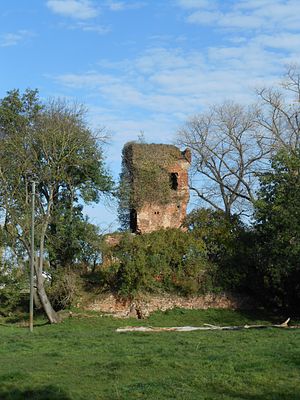Groß-Vernich Castle
| Groß-Vernich Castle | ||
|---|---|---|
|
Grossvernich castle tower ruins |
||
| Creation time : | around 1342 | |
| Castle type : | Niederungsburg | |
| Conservation status: | ruin | |
| Standing position : | Noble | |
| Place: | Weilerswist - Grand Vernich | |
| Geographical location | 50 ° 44 '29.1 " N , 6 ° 50' 2" E | |
|
|
||
The castle wholesale annihilation is the ruins of a moated castle in the district United destroyers of the municipality Weilerswist in Euskirchen in North Rhine-Westphalia .
The originally two-part castle has been exposed to unhindered decline since the 18th century. The name Vernich comes from the noblemen of Vernich, a branch of the House of Tomburg . First there was a more important old castle of the Vernich family south of Groß-Vernich. This castle was first mentioned in 1342 when it was given to Count von Jülich by Herr von Vernich . Rebuilt by Johann Brent von Vernich in the middle of the 14th century, the castle was besieged by the Cologne residents in 1370, as Johann's son Reinhard was known as a robber baron . Under his son Goswin, also a robber baron, the castle was so badly destroyed in 1460 that he had to rebuild it and make peace with Cologne. When the Vernich family died out, the old castle fell into disrepair and the associated lordly rights were transferred to the two castles Groß-Vernich and Klein-Vernich .
In 1541 Daem von Orsbeck became the new fiefdom bearer of the subordinate rule Groß-Vernich, whose descendants obtained high offices and dignities in the Duchy of Jülich and were raised to barons . With Johann Hugo von Orsbeck zu Vernich, the last heir was born at the castle in 1634, from 1676 he was elector and archbishop of Trier . In 1711 his brother-in-law Wolf Ernst von Schmidtburg inherited the property. His son sold the property to his cousin Karl-Kaspar von Metternich-Müllenark. After the Metternichs died out in 1754, the already ruined castle was awarded to Baron Sigismund von Roth, who was married to a Metternich. At this time the subordination was abolished and the outer bailey burned down in 1810. At the end of the 19th century, Engelbert Fischenich acquired the castle ruins and the remaining land, whose descendants still own the area today.
literature
- Dirk Holterman, Harald Herzog: The Euskirchener Burgenrunde - cycling between Erft and Eifel. Walter Rau, Düsseldorf 2000, ISBN 3-7919-0750-6 , p. 24 ( online ).


